Badgers lead WCHA ‘Final Six’ into NCAA
By John Gilbert
Five of the six WCHA teams that were selected to play in the 16-team NCAA tournament this week — St. Cloud State, Minnesota, North Dakota, Denver, and Minnesota State-Mankato — are primed to get a second chance to regroup and show their best stuff in the win-or-go-home NCAA, with hopes a national championship might be the pot of gold at the end of the rainbow.
But the sixth team, Wisconsin, is so used to playing, and succeeding, with the same win-or-else obstacle, the Badgers would just as soon have nothing change.
Just like in the NCAA field, only one team can win the championship in the WCHA Final Five, and that team was Wisconsin, which continued its upward surge that has carried the Badgers since the end of November. After starting 1-7-2 in their first 10 games, the Badgers have soared to a 21-5-5 mark, for a 22-12-7 overall record as they embark on a very challenging NCAA schedule.
Freshman Nic Kerdiles, who formed a strong connection with linemate Tyler Barnes as they finished 1-2 in Final Five scoring — Kerdiles 3-3–6 and Barnes 4-1–5 — had an ineligiblity issue with contact from an agent after being drafted on the second round by Anaheim, and missed the first 10 games. Ten games was precisely when the Badgers went 1-7-2, so they are 22-12-7 with him in the lineup. They flank center Mark Zengerle on the top line that suddenly has emerged as a dangerous unit, every shift.
Behind their play, and that smothering defense, the Badgers rose form a three-way tie for fourth, fifth, and sixth in the WCHA to claim the automatic slot in the NCAA field by winning the Final Five, and coach Mike Eaves and his players knew that they came to the Xcel Energy Center in Saint Paul, Minnesota, with the task of winning three games in three days, or being done for the season.
Eaves was asked if this, because of the slow start, has been his most challenging season. “Challenging?” he said. “I’d say it was one of the most enjoyable.”
The start was puzzling, he acknowledged. “We weren’t playing terrible hockey,” Eaves said. “We were playing well, we just weren’t coming up with the big goal when we needed it. I was just trying to say the right things to these young men to keep them coming back.”
There was no question they were coming back. Captain John Ramage said: “At the start, even though we didn’t win, we knew exactly what kind of team we had. If we didn’t feel that, we wouldn’t be here rightd now. Our confidence level is high, and we’re riding high — we just want to keep it going.”
Wisconsin is in the Northeast Regional, as the tournament’s No. 14 seed, where the first opponent is Hockey East power Massachusetts-Lowell, the No. 3 overall seed, in a 3:30 p.m. game on Friday at Manchester, N.H. The other teams in the Northeast are No. 7 New Hampshire, also from Hockey East, against Denver, No. 9, from the WCHA, at 7 p.m. The winners collide on Saturday, at 5:30.
The other WCHA entries are also spaced, two each, in the West Regional at Grand Rapids, Mich., where Minnesota, No. 2 overall, opens the tournament at 1 p.m. Friday against No. 15 Yale from the ECAC, with No. 8, North Dakota, facing No 10 Niagara at 4:30 p.m. Those winners play Saturday at 3 p.m.
In the Midwest Region, at Toledo, Ohio, games begin on Saturday, with St. Cloud State, No 13, playing No. 4, Notre Dame of the CCHA, at 12:30 p.m., and MSU-Mankato, No. 11, facing No. 5 Miami at 4 p.m., with the winners meeting Sunday at 3 p.m. for a Frozen Four berth. The East Region, the only one where no WCHA team is slated, also starts Saturday, with No. 1 overall Quinnipiac facing No. 16 Canisius at 4:30 p.m. in Providence, R.I., and No. 6 Boston College, meeting No. 12 Union at 8 p.m. Those winners play at 5:30 p.m. Sunday.
As far as using the NCAA tournament to make up for WCHA playoff disappointments, the rest of the entries have a lot of challenges. St. Cloud State won the regular season title, although they were tied on the final day of the season by co-champion Minnesota. Both flopped after sweeping two games to reach the Final Five, with byes into the semifinals. St. Cloud State fell victim to Wisconsin, which pinned a 4-1 defeat on the Huskies. Minnesota was stymied by red-hot Colorado College, which knocked out favored North Dakota 4-3 in overtime, then beat the Golden Gophers 2-0.
As the top seed in the WCHA, the Huskies incomprehensibly were victimized by the NCAA’s computer system, relegated to the No. 13 seed, while co-champ Minnesota is No. 2, after ranking No. 1 a week earlier. The Huskies have a consistently solid team that plays well at both ends of the rink, but they seemed to fall victim to Wisconsin’s tournament rhythm. After winning their first WCHA league title in their final year in the league, the Huskies need no more incentive than to realize they worked six months to prove they are the best team in the WCHA, then they got far less respect than the league champs from the CCHA, Hockey East, or the ECAC.
Meanwhile, nobody has more ground to make up than Denver, which was upset by Colorado College after winning the first game, then losing twice at home to the Tigers, who were, arguably, the hottest team in the Final Five but knew all along it was win the title or else. Denver, it must be noted, has in its history an NCAA title after losing in the WCHA first round but maintaining a high enough rank to still make the NCAA, rested and ready.
North Dakota, stung by the overtime upset loss to CC in the Final Five quarterfinals, had won three straight Final Five titles, and ranks with the Gophers as co-favorites at Grand Rapids, where they could meet for the final time as WCHA rivals, with both teams going to other conferences next fall — Minnesota to the Big Ten and North Dakota to the National Collegiate Hockey Conference.
And Minnesota State-Mankato had a rough night in a 7-2 shocker against Wisconsin in the Final Five quarterfinals. The Mavericks, with a solid team and the league’s top goaltender in freshman Stephon Williams, had a miserable night and will welcome the reprieve of the NCAA selection — even though most hockey observers are completely overlooking their chances against powerful Miami.
All those five other teams could pile up a mountain of alibis and excuses for their shortcomings in the Final Five, but only Wisconsin can look back at last weekend knowing they have climbed to the top of one pinnacle, while looking ahead to the next one.
“It didn’t look like that early,” said Badger coach Eaves. “We had injuries, ineligibilities, an assistant coach leaving, and a problem scoring goals. But we are what we are today, because of those lessons we learned back then.”
After their terrible start, which included losing twice to Colorado College in Madison, tying and losing at Minnesota, then losing twice at MSU-Mankato, the Badgers tied and won at Denver, then tied Michigan Tech twice. Then Wisconsin took off, winning seven in a row. Thereafter, the Badgers never lost two games in a row, splitting nonconference games with Miami, sweeping Alaska-Anchorage, tying and losing at North Dakota, tying and winning against Bemidji State, splitting with arch-rival Minnesota, splitting a nonconference pair with Penn State, then sweeping at Nebraska-Omaha, and splitting with St. Cloud State.
Still, the Badgers have hit their peak in playoffs, sweeping Minnesota-Duluth, then beating Mankato, St. Cloud State, and Colorado College in five games that have seen them outscore those foes 21-7, as goaltender Joel Rumpel and the stifling Badger team defense has prevailed.
“They play a different style, and they’re so dialed into it, we were always a step behind,” said CC coach Scott Owens, of the Badgers.
The Broadmoor Trophy, given to the Final Five champion, is the last one Wisconsin will be playing for, and Eaves said, “It’s very special, and we will hold it in high esteem.”
But after his Badgers had won it, and were taking turns holding it high overhead on the Xcel Center ice, Eaves stood smiling on the bench, then walked down the runway to the dressing room, rather than joining them on the ice.
“That’s their moment,” said Eaves. “Watching them get together afterward was really fun, but it’s their moment.”
WCHA sends 6 to NCAA in Final Flourish
By John Gilbert
The Western Collegiate Hockey Association is not dying after this season, it just seems that way. The most successful conference in any sport is exploding to form three different leagues, while the rival CCHA is also going to be shattered, with the remnants joining what will remain of the WCHA to make up the WCHA as of next fall.
To briefly explain: Minnesota and Wisconsin were forced to join Michigan, Michigan State, Ohio State and Penn State in a new Big Ten hockey conference. The Big Ten says any time as many as six of its member schools play a sport, that sport must be a Big Ten league. With Penn State starting hockey — and the Nittany Lions upset Wisconsin in Madison for a split late this season! — that was the sixth Big Ten team. That caused some unrest and instability within the remaining WCHA entries, and North Dakota and Denver led an insurrection to start a new league.
Denver and North Dakota coerced Colorado College, Nebraska-Omaha, and Miami of Ohio to start the new National Collegiate Hockey Conference (NCHC), and UMD had to choose quickly, and jumped on board. That made for a six-team elitist league, which added St. Cloud State and Western Michigan to make eight.
That leaves Bemidji State, Minnesota State-Mankato, Michigan Tech, Northern Michigan, Lake Superior State, Alaska-Anchorage, Alaska-Faribanks, Bowling Green, and Ferris State in an interesting league, and Alabama-Huntsville joined as well, making 10. That group will still be called the WCHA, which is great, because historically it will give the new league a standard to strive for.

CC's Rylan Schwartz (13) set up Charlie Taft for a goal on Joel Rumpel, but Wisconsin won the WCHA title game 3-2.
All of that means that the WCHA’s Final Five last weekend was loaded with historical significance. And it was also loaded with surprises and upsets. Wisconsin beat Colorado College 3-2 in the championship game, which can be called the “final Final Five final.” The title game had added drama, because all the computer calculations said that while the winner would get the automatic berth in the NCAA tournament’s 16-team field, the loser would not make it. Both finalists had played two amazing games to reach the final. Wisconsin stunned MSU-Mankato 7-2, then shocked No. 1 seed St. Cloud State 4-1, while Colorado College — which finished eighth in the regular season WCHA race — knocked off North Dakota in overtime, then played a magnificent game to beat Minnesota 2-0. Rarely does a team succeed having to win a quarterfinal, the beat a bye team in the semifinals, and then win the third game in three days. But in this case, both teams had to play their third game in three days, and because CC’s games were far more grueling than Wisconsin’s, the Tigers seemed more worn out in the final, but played with great heart, and the spark of Rylan Schwartz, to challenge the Badgers. Wisconsin obviously deserved to reach the NCAA, having eliminated UMD in two straight, then Mankato, St. Cloud and CC.
The Badgers, with their shut-down style and opportunistic offense, have freshman Nic Kerdiles and Tyler Barnes as first-team wingers who have amazing chemistry for finding each other with passes. As the 14th seed, lowest among WCHA entries, the Badgers are a legitimate threat to win the Northeast Regional and make a run at the NCAA title.
But the most impressive team in the Final Five was Colorado College, both for the grit and tenacity they showed in beating Denver by winning two games after losing the first, and then taking out North Dakota in overtime, but mostly for the flawless, free-flowing offense that left the Golden Gophers looking more befuddled than any co-champ should look in the 2-0 semifinal.
The worst call of the tournament came in the first period of Wisconsin’s 4-1 victory over St. Cloud State. A 2-on-1 rush, with a shot from the right side blocked by Badger goalie Joel Rumpel, with the rebound landing in the slot. As Nic Dowd shot the rebound toward the open goal, Rumpel turned from the congestion of the shooter and his defenseman, pulled his stick free, and whirled to try to get in the way of Dowd’s shot. No chance. So Rumpel let his stick slide, knob-first, from his grasp, diagonally across the crease toward the left post. Incredibly, Dowd’s shot hit the handle of the stick and slid just centimeters wide of the left pipe. Had Dowd scored, St. Cloud would have led 2-1 at the second intermission.
St. Cloud State coach Bob Motzko discussed it with the referees, who agreed to check with Greg Shepherd, supervisor of officials, upstairs manning the video replays. The rule book doesn’t say such a play is a penalty — it is a goal, anytime a player throws or slides his stick to prevent the puck from obviously going into the goal! AAfter repeated viewings, the ruling was no goal. I asked Shep about it, and he said one replay showed that Rumpel’s stick hit his teammate’s skate, which knocked the stick out of his hand, meaning he didn’t throw it. We had a pretty good argument about it, but I saved my coup de grace for the end. In the interview room, Rumpel said: “I guess I kind of dove and it hit the knob of my stick, and knocked it out of my hand. But the puck just skirted wide.” For clarification, I raised my hand and asked: “Are you saying another player knocked the stick out of your hand?” And Rumpel said: “No, nothing hit my stick, except the puck.” I told Shepherd he had to call it the way he saw it, but the goaltender himself acknowledged he threw his stick at the puck, and was quite jovial about accepting credit for the accuracy of his “Olympic Stick Slide.”
Badger coach Mike Eaves said, simply: “Obviously, it was the turning point in the game.”
SIX WCHA TEAMS MAKE NCAA
The last hurrah for the WCHA as we know it should be a good one, because six WCHA teams made the 16-team NCAA field, which begins with four regionals this week. On Friday, the show starts with Minnesota facing Yale at 1 p.m. in Grand Rapids, Mich., followed by the North Dakota-Niagara game at 4:30. Don’t look ahead, but very likely we’ll see a Minnesota-North Dakota showdown at 3 p.m. Saturday in that West Region final — two teams that are leaving the WCHA for new horizons next year.
The Northeast Regional follows with Wisconsin facing Massachusetts-Lowell at 3:30 in Manchester, N.H., followed by Denver facing New Hampshire at 7 p.m. Those winners meet at 5:30 p.m. Saturday.
The other two regionals are Saturday-Sunday, with the East Regional pitting top overall seed Quinnipiac against Canisius in an odd match between two programs that were basically not on the horizon of elite teams three or four years ago. That will be at 5:30 p.m. Saturday in Providence, R.I., and will be followed at 8 p.m. by Boston College facing Union. Those winners play at 3 p.m. Sunday in the only region that doesn’t have a WCHA team, because the NCAA will do anything to avoid the situation a few years ago when all four Frozen Four teams were from the WCHA. Frankly, it was no fun; more like a rerun of the WCHA Final Five.
The Midwest Regional in Toledo has Notre Dame facing St. Cloud State at 12:30 Saturday, followed by Miami facing MSU-Mankato at 4 p.m. The winners meet for a Frozen Four berth at 3 p.m. Sunday. That’s an interesting region, because Notre Dame and Miami, both leaving the CCHA, will be favored over the 11th-seeded MSU Mavericks, and the No. 13 seeded St. Cloud State Huskies. But both the Mavericks and the Huskies have dangerously talented teams, and have the unique opportunity to make up for disappointing showings in the Final Five. And upset or two there, wouldn’t surprise me.
One thing about the NCAA’s convoluted ratings and computer calculations that has bothered me for a couple of decades. All of that computer stuff and Pairwise calculations are impressive. But the NCAA should be made aware of this thing each league has, called “Standings.” Nonconference games are important, but they are too important with the computer involvement. Used to be that teams could play a few back-up players in nonconference games; now they have to play them for keeps. To me, the conference standings are all-important, and should be given extra weight in the computer input. In the WCHA, St Cloud State was caught and tied for co-championship by Minnesota in the last game of the season, but St. Cloud State was No. 1 seed on tie-breakers. My plan would have each league submit its standings — including league tournaments, if they wish. In the WCHA, St. Cloud State would rank No. 1, Minnesota No. 2, North Dakota No. 3, etc. That’s the way they finished in their tough and exhausting league race. There should be no computer that can say that Minnesota, North Dakota, Denver, and MSU-Mankato should be seeded higher than St. Cloud State — the league’s top seed.
It would, however, be great to see the WCHA as we know it supply a couple of Frozen Four teams and win the national championship as its own going-away gift to the WCHA.
GOPHER WOMEN WIN TITLE AT 41-0
The University of Minnesota women’s team completed a pressure-filled playoff by loosening up and playing its game to beat Boston University 6-3 in the NCAA championship game Sunday at Ridder Arena. A sold-out Ridder Arena, with 3,500 fans jammed in, saw the Gophers become the only women’s team to ever go all the way through the season undefeated and untied, at 41-0. Their winning streak is now at 49 and counting, with their second straight title. Amanda Kessel, the Kazmaier Award winner, finished a brilliant season with two goals and two assists, giving her 46-45–101 for the season.
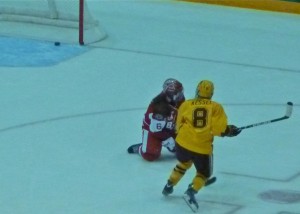
Amanda Kessel's 2nd goal, 46th of the year, enters empty BU goal to clinch 6-3 NCAA final victory for Minnesota.
That victory followed two very tough games, with the Gophers surviving a triple-overtime quarterfinal before beating North Dakota, then getting past Boston College 3-2 in overtime in the semifinal. The weight of the undefeated season started to get a little heavy once Minnesota got to elimination games, which made the title game a relaxed and relieved performance.
The media, most of which had never paid any proper attention to women’s hockey, jumped all over the bandwagon to claim that this Gopher team is the greatest women’s team ever. I say this team has the greatest record of all, but it can’t be assumed it’s the best team ever. Its statistics are impressive: Kessel’s 46-55–101 is followed by Michelle Brandt’s 33-49–82, and ace defenseman Megan Bozek’s 20-37–57. And senior goaltender Noora Raty has been positively brilliant.
It is apparent that this Gopher team is among the best ever, but let’s look back at the repeat Gopher title-winning teams of 2003-04, and 2004-05. In those years, UMD was also a truly elite power, having won the first three NCAA titles, in 2000, 2001, and 2002. They were still loaded with elite players in the years the Gophers won, and Wisconsin was coming on strong, with a roster full of players that would win the following two titles.
In 2004-05, for example, the Gophers were 36-2-2 overall, compared to this year’s 41-0, and they were 25-1-2 in WCHA play, compared to this year’s 28-0. The difference is that beat the Gophers in league play, and UMD and Wisconsin each pinned ties on the Gopher record. North Dakota and Wisconsin were pretty strong this year, while UMD and Ohio State were a notch back, but none of those four approached the elite quality of UMD, and the emerging Badgers, of a decade ago. That accounts for the slight difference in losing a game or two and going undefeated.
Look also at the team statistics. In the 04-05 title year, Minnesota’s top three scorers were Natalie Darwitz, with 42-72–114, Krissy Wendell, with 43-61–104, and Kelly Stephens, with 33-43–76. Those were in 40 total games. In all-time Gopher scoring, Darwitz has 102-144–246 in 99 games; Wendell 106-131–237 in 101 games; and Stephens 97-121–218 in 148 games. Nadine Muzerall, who played with Darwitz and Wendell on the 2003 title team, amassed 139-96–235 in 129 games.
Kessel has 97-134–231 for her three years so far, in 113 games. Kessel is joining the U.S. team for the World Championships right now, and is a cinch to make the U.S. Olympic team, which will take her away from the Gophers for a season. When she comes back, she is certain to pass Muzerall, and Stephens, Wendell and Darwitz to become the top Gopher scorer of all time. But before we anoint her as the best ever, let’s appreciate that like Kessel, Wendell and then Darwitz were chosen outstanding players of the 2003 and 2004 NCAA Frozen Fours, respectively, with Darwitz scoring 3-6–9 in the 2004 event.
In the meantime, we also cannot look beyond those first three UMD teams, all of which won the NCAA titles. in 1999-2000, the Bulldogs went 25-5-3, with a 21-1-2 record in the WCHA. In ’99-2000, Jenny Schmidgall led the league with 41-52–93, with Minnesota’s Muzerall the top goal-scorer at 49-28–77 in second, and then came UMD’s Maria Rooth 37-31–68, and Hanna Sikio 25-39–64. In WCHA play, the top four UMD scorers were Schmidgall (who became Jenny Potter) 36-46–82; Rooth 31-28–59; Sikio 22-32–54, and Erika Holst 23-18–41. At the end of the Schmidgall/Potter-Rooth years, along came Caroline Ouellette, another elite player. We also should point out that while Potter was the best player on the U.S. women’s teams for several years, until Darwitz and Wendell came along to give the U.S. three superstars, Rooth was clearly the best player on Sweden’s national and Olympic teams, as was more recent UMD goaltender Kim Martin, who beat the heavily favored Team USA in the 2006 Olympics, while Sikio and goaltender Tuula Puputti were brilliant for Finland, and Ouellette became the best player on Canada’s Gold Medal teams.
We could go on, and evaluate the stars at Wisconsin during the four Badger championship years — one of which included only one loss (to UMD) and two ties. Suffice it to say that Amanda Kessel may play up to the amazing standards Potter, Darwitz and Wendell have set for the U.S. in international play, and this year’s undefeated Gopher team is definitely at the level of those Darwitz-Wendell Gopher teams, and the Potter-Rooth-Ouellette Bulldog teams, and the elite Badger teams.
It’s certainly not Minnesota’s fault that the competition was a definite cut below the level that featured the Gophers, Bulldogs and Badgers all with elite teams that would take turns beating each other. Nobody could go undefeated in those seasons. But coach Brad Frost has maintained the flow of elite players to the Gophers, while UMD and Wisconsin have run thin in that department. The Gophers, without question, deserve all the accolades of their fantastic unbeaten, untied season, but those who have just discovered women’s college hockey should be cautious about declaring them the best ever.
Gophers repeat as women’s champ at 41-0
By John Gilbert
MINNEAPOLIS, MINN. — Minnesota finished a women’s hockey season that coach Brad Frost said was surreal. Not just surreal, but “very surreal.” The Golden Gophers put down a very dangerous Boston University outfit 6-3 Sunday afternoon before a sellout crowd of 3,400 at Ridder Arena to win their second NCAA championship in a row, and to complete the first undefeated, untied season in women’s college hockey history.
So dominant was Minnesota all season that the debate has already started about whether this is the greatest women’s team ever, and that’s one that could go into the night with valid points in favor, and with some about how much more competitive the top teams in the WCHA were a decade ago when Minnesota, Minnesota-Duluth, and Wisconsin beat each other up. But nobody can argue with that one fact: a 41-0 record will go into the books as a record that won’t ever be broken, and is extremely unlikely to even approach being duplicated.
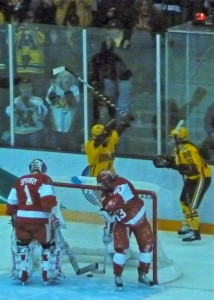
Minnesota's Amanda Kessel, left, set up Hannah Brandt's 33rd goal for a 2-0 lead, and the two celebrated.
“You just saw a record-breaking team play another great team,” said Boston University coach Brian Durocher, whose team finished 28-6-3. “Nobody’s ever gone 41-0 before, and I tip my cap to them for what they’ve accomplished. But I was proud of our team too. The shot count didn’t get away, and the territorial didn’t get away. I love everything about our team. They were down 2-0, 3-1, 4-1, and they never quit. They fight to the end.”
One of the reasons the Terriers were dangerous to the end was that the Gophers had actually looked beatable in their two previous games — a 3-2 triple-overtime marathon in the NCAA quarterfinals against North Dakota, a team they had shut out 2-0 in the WCHA Final Faceoff final the week before, and a quite similar 3-2 overtime victory over Boston College in Friday’s NCAA semifinals.
But the Gophers lived up to the motto Frost had presented them with for this season, and left no doubt in the title game, scoring twice in every period.
“Last year, our motto was ‘Prove it,’ and this year, it was ‘Leave no doubt,’ ” said Frost. “On Day 1, I told the team we had to focus on the process, the things we had to do to win. I told them we’re going to lose a game here and there, but let’s focus on the process. And here we are, 41 games later. It’s incredible.
Captain Megan Bozek said: “I don’t think we focused on being unbeaten. You guys in the media ask us about it all the time, so we have to think about it. But I don’t think it ever got to be something that bothered us.”
Frost, however, said later that he thought the undefeated streak did have an effect. “I think it started to weigh on them once we got to the one-and-done playoffs,” he said. “But tonight, we played free.”
And, they left no doubt.
It took a power play to get Minnesota untracked midway through the first period for a Mira Jaluso goal, then Hannah Brandt scored her 33rd goal of an amazing freshman season, short-handed, at 18:32 for a 2-0 lead.
The Gophers followed up on that formula, scoring twice in every period, with Patty Kazmaier Award winner Amanda Kessel getting her 45th goal late in the second and Milica McMillen connecting two and a half minutes later. In the third, defenseman Rachel Ramsey scored, and Kessel finished off the offense with a colorful empty-net goal in the final minute for No. 46.
Kessel, goaltender Noora Raty, and captain and defenseman Bozek shared the post-game interview podium with Frost. Those three were the three finalists in the Kazmaier competition for best women’s college hockey player in the country.
“I don’t know if you can draw up a better scenario,” Frost said. “To go 41-0, and have the three best players in the country on this team, it’s something I can’t even put into words.”
Despite the steady offense, the Gophers were never completely clear of the hustling and well-prepared Terriers. After Brandt’s short-handed goal, BU came back 16 seconds later, still on the power play, for a goal by Sarah Lefort, who pulled a rebound clear and backhanded it past tournament most outstanding player, Noora Raty, in the Minnesota goal, cutting it to 2-1.
And, trailing 4-1 after two, Boston University’s spectacular junior center Marie-Philip Poulin scored with a 40-foot one-timer blast from the slot at 1:48 of the third period to lift the Terriers within 4-2.
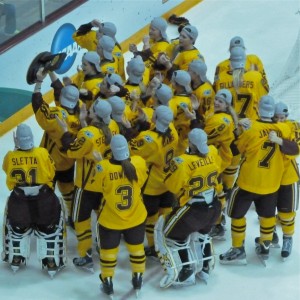
The Gophers skated over to their band's section to share their second straight NCAA women's championship trophy.
“The key in the game was to get the lead,” said Kessel. “But it was never safe. When we were ahead 4-2 in the third period, Poulin walks in and Noora made a great save. It could have been 4-3, but instead we went down and made it 5-2.”
That was when Ramsey scored on a tap-in at the crease with 4:33 remaining. Even at 5-2, however, the persistent Terriers came back again to make it 5-3 with 2:52 left — 6 seconds after a Minnesota time out.
“I called time because our line had been out there too long, so I wanted to get fresh legs out there,” said Frost. “I called time out, they pulled their goalie and scored on the next shift.”
Within two again, which puts a team in striking distance, made the last three minutes more important, and it also made Kessel’s empty-net goal with 49 seconds remaining the first moment the Gophers themselves were assured there was, in a phrase, no doubt.
Badgers hold off CC 3-2 in final Final Five final
By John Gilbert
SAINT PAUL, MINN. — Wisconsin goaltender Joel Rumpel’s nickname is “Sunshine,” which might imply that linemates Tyler Barnes and Nic Kerdiles could be called the moon and the stars. Collectively, they sent the Badgers into NCAA tournament orbit with a 3-2 victory over Colorado College Saturday night that provided an out-of-this-world reward of the Broadmoor Cup as well.
The two teams were not only playing for the final Red Baron WCHA Final Five championship, before 18,782 fans at Xcel Energy Center — Wisconsin is heading for the Big Ten Conference next season, and CC to the new National Collegiate Hockey Conference — but the loser would fall from the scope of the 16-team national tournament field of candidates. After all that the Badgers have endured this season, all it took was some more of that patented execution, some Rumpel sunshine in goal, and another dose of what seems to be their private stock of karma.
Barnes scored the pivotal first goal of the game to stake the Badgers to a 1-0 lead in the closing seconds of the first period. Sean Little’s tip made it 2-0 to open the second, and trying to come back against the stifling defensive style that coach Mike Eaves has convinced his player of using is a lot like running in quicksand.
Outshot 33-22, including 9-4 in the third period, Colorado College did battle back, behind the amazing dynamo named Rylan Schwartz, who set up Charlie Taft for a flashy goal to cut the margin to 2-1, and scored an impressive breakaway goal to end the second period and close the gap to a workable 3-2.
The third Badger goal gave Wisconsin a 3-1 edge when Kerdiles went to the right edge of the net and smacked in the rebound of a shot by goal-crashing John Ramage. That meant that despite the presence of the ever-dangerous Schwartz, the 3-2 lead was in good with Rumpel in goal.
“We were tired, our D-corps was tired,” acknowledged CC coach Scott Owens. “And this game was a different style. Wisconsin is so dialed in to their defensive system, and they execute it so tightly, we were always a step behind. But I’m very, very proud of our guys. This was our eighth straight road game. But we had a strong will to keep it going. Rylan Schwartz was an absolute man out there, making big-time plays at big moments.”
The way the Badgers are playing now makes the beginning of the season seem distant. During that dismal 1-7-2 start, junior Tyler Barnes couldn’t seem to buy a goal, and freshman Nic Kerdiles was unable to play, ruled ineligible for allowing a pro agent to get too close to him during the NHL draft. As the season moved on, Kerdiles found a home on the Badgers first line, with Mark Zengerle centering him on the left and Barnes on the right. “Their chemistry has caught on,” said Eaves.
That chemistry has been apparent through the playoffs. The Badgers swept Minnesota-Duluth 3-1 and 4-1, with Kerdiles and Zengerle scoring goals in the first game and Barnes getting one in the second. Then came the Final Five, and Barnes scored twice and Kerdiles once in the 7-2 shocker against Minnesota State-Mankato, and Kerdiles and Barnes each scoring a goal in the 4-1 semifinal victory over St. Cloud State. With each getting a goal in Saturday’s final, it means Barnes and Kerdiles have combined for nine goals in five playoff games.
Kerdiles was voted most valuable player of the Final Five, and joined Barnes and CC star Schwartz as the all-tournament forwards. John Ramage of the Badgers and Peter Stoykewych of the Tigers were the defensemen, and Rumpel of the Badgers the goalie.
“Joel’s nickname is Sunshine,” said Eaves. “He’s got the perfect goaltender attitude because he remains calm when people are flying all around him. He makes things look easier than they are because of his demeanor.”
The Badgers are in the midst of a surge from a faltering 1-7-2 start to a 22-12-7 record, and a certain spot in the 16-team NCAA tournament field that will be announced Sunday. Colorado College, which showed such great tenacity in stringing together four consecutive upset victories, finishes 18-19-5, knowing that only a championship and its automatic berth could push the Tigers to the NCAA field.
The fresher Badgers gained a touigh 1-0 lead in the final minute of the first period, and made it 2-0 early in the second, staying ahead at 3-1. But Rylan Schwartz, CC’s version of Superman to the Tigers offense, set up one goal and scored the other to close the gap by the end of the second period. His presence meant that CC was a threat to tie the game until the closing seconds.
The safest assumption was that the title match would be a goaltending duel between Rumpel and CC’s Joe Howe. Rumpel had allowed three goals in his victories over MSU-Mankato and St. Cloud State, while making 68 saves, a save percentage of .957; Colorado College’s Howe had allowed three goals in beating North Dakota in overtime and blanking Minnesota, and made 64 saves, a percentage of .955.
The first period was just such a duel, as both goalies were solid. The Badgers outshot CC 13-9, and it was the 13th shot that gave the Badgers a 1-0 lead. Frankie Simonelli shot from the left point, and Kerdiles deflected it on net. Howe blocked it, but the rebound landed in the left side of the crease, and Tyler Barnes smacked it in, with 17 seconds remaining in the first period.
“It could have been a different game if we didn’t score first,” said Eaves. “Congratulations to CC. They had a lot of heart and soul, and they put all of it out there.”
Both teams had plenty of reason to plead exhaustion, with the title game being their third in three days. For Colorado College it was worse, because they had to go all three games to upset Denver the previous weekend, which meant Saturday’s final was the Tigers sixth game in nine days. And the Tigers did seem to sputter a bit in the second period.
The Badgers had something to do with that, of course, deflating the CC hopes when Jake McCabe’s point shot was deflected by Sean Little past Howe for a 2-0 lead at 3:28.
Colorado College gained a little spark at 7:19, when Schwartz rushed up the left side to create a 2-on-1, and sent a perfect goal-mouth pass to Charlie Taft, who banked it in at the right edge to cut the Wisconsin lead to 2-1.
The Tigers dodged a bullet when a Wisconsin power-play goal was disallowed midway through the period, because the rebound of Ryan Little’s wide-angle shotpopped up off the goalie’s mask and, video reviews proved, brother Sean Little batted it in with his gloved left hand at about waist height.
But at 16:15, Wisconsin scored a legitimate third goal. John Ramage rushed up the right boards from the point, curled deep and veered out in front. Howe blocked his backhander, but Nic Kerdiles rapped in the rebound at the right post for a 3-1 lead.
That appeared to settle Colorado College’s hopes of going all the way to the Final Five title — the Tigers only hope of reaching the NCAA tournament’s 16 selections. The Tigers passes lacked crispness, and accuracy, and the second period was wearing down into its final minute.
But then, Schwartz to the rescue again. Alexander Krushelnyski picked the puck off the left boards in his own end and spotted Schwartz trying to break past defenseman McCabe. Krushelnyski quickly zipped a pass up the middle, and Schwartz broke in, fighting off repeated hooking attempts by McCabe, then making a great deke before firing a shot past Rumpel with 27 seconds left in the middle period.
Exhaustion seemed to be a secondary foe for the Tigers in the third period, but as the final period wore on, exhaustion seemed to be getting the upper hand.
Owens pulled Howe for an extra attacker with 1:10 remaining, and as the Tigers rallied furiously, CC’s William Rapuzzi was called for tripping with 9.4 seconds remaining, and the last gasp was extinguished.
Howe, upstart CC shock Gophers with 2-0 shutout
By John Gilbert
SAINT PAUL, MINN. — Joe Howe says he never looks back, even while his goaltending has turned sizzling hot while taking down one favored foe after another. Friday night, before 18,949 fans at Xcel Energy Center, Howe stopped all 35 shots he faced and led Colorado College to a 2-0 shutout that seemed to baffle No. 1 ranked Minnesota.
But now that game is in the past, so Howe and the upstart Tigers — who hit the .500 mark for the season at 18-18-5 — must refocus on Saturday’s 7 p.m. championship game of the Red Baron WCHA Final Five tournament against Wisconsin. Usually, if one team has to win three games in three days to win the Final Five, it is near impossible to beat an opponent playing only its second game, but in this case both CC and Wisconsin have won their way to the final with two victories, so the fatigue factor is a wash.
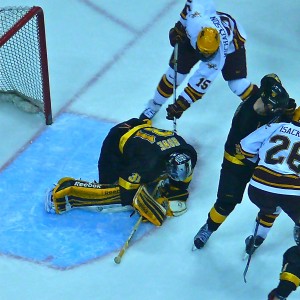
Minnesota's A.J. Michaelson tried in vain to smack a rebound past CC goalie Joe Howe in Tigers 2-0 semifinal shocker.
If there was a tournament darling, it would be Colorado College. And if ESPN covered college hockey, the goals by Rylan Schwartz to open the second period, and by Charlie Taft less than four minutes later, would be highlight video material, although they didn’t seem insurmountable to the explosive Golden Gophers, one of the highest scoring teams in the country. It seemed almost a matter of time before the Gophers would break through.
But Howe was cat-quick in goal against the best Minnesota chances, and the CC defense was superb, blocking shots, deflecting pass attempts, and quite calmly clearing the zone with sometimes soft but accurate passes, to forwards who swept down the ice making short, effective passes along the way.
While Howe praised his teammates, he said he doesn’t think about how hot he’s been recently. “I never think about what’s already happened. I only think about what’s next,” Howe said.
“Rylan put a note up that said we don’t have to win three games, we have to win one game three times,” Howe added. “It felt good. We know we’ve got to win it to move on, and we had a good team effort tonight, and our penalty killing was unbelievable.”
The Gophers, who had a bye into the semifinals as WCHA co-champion and No. 2 seed, had a bit of an edge in the first period, but Colorado College was in the midst of its seemingly impossible mission — to rise from eighth place and then conquer all those higher seeds in the Tigers path. First it was Denver, which won the first of a best of three, only to lose the next two to CC. Then it was the Final Five quarterfinals, and a scintillating 4-3 overtime upset of North Dakota, the three-time defending Final Five playoff champs.
But Minnesota, playing in its “second home,” 8 miles from Mariucci Arena, seemed too big a challenge even for a team desperate enough to throw caution to the winds. Minnesota, repositioned as the No. 1 ranked team in the nation this week, is secure as a top seed in, probably, the Grand Rapids, Mich., NCAA regional; Colorado College knows that when it loses, its season is over, and only a victory in the Final Five title game will give the Tigers a chance to enter the NCAA’s 16-team field, as the WCHA’s automatic qualifier.
“Credit CC,” said Lucia. “They came in here having won two at Denver, then they beat North Dakota and now us in here. Joe Howe gave them the kind of goaltending you need at a time like this. Usually, when you give up two goals, you should be in a good position to win the game. But Howe was very good. When we played them earlier, he didn’t play either game.”
Colorado College coach Scott Owens explained that. “We had goaltending issues till early January,” he said. “Then we decided to give him the ball, and slowly, he’s gotten better and better. He used to make three or four great saves, then let in a soft one. He’s not doing that any more.”
No soft ones, and no hard ones, either, such as when the Golden Gophers outshot CC 12-6 in the first period, but Howe and Minnesota’s Adam Wilcox kept it 0-0. It was the opening shift of the second period, when Schwartz changed the game.
Schwartz carried across the Gopher blueline, with defenseman Jake Parenteau dropping back. Schwartz pulled the puck slightly, then let fly with a rising shot that skimmed between Parenteau’s stick and leg and snared the upper left corner of the net, past the screened Wilcox, at 0:59.
“I was thinking about cutting to the middle, and I was hoping the goalie wouldn’t see me,” said Schwartz, whose goal was his 19th this season.
The Tigers, rushing with a constant sequence of soft, short passes, attacked again three minutes later. This time Wilcox repelled the attack, but as the Gophers impatiently hurried on their breakout, Alexander Krushelnyski, who had dropped back to the offensive blueline, lunged forward and poke-checked the puck away, back into the slot. Charlie Taft was there, and he darted to his right and as Wilcox dropped in anticipation, Taft fired back between his pads, and it was 2-0.
“I was a little lucky on that one,” said Taft, a sophomore from Edina. “I wasn’t trying for the 5-hole, I was just trying to get it on net.”
After that, it was back to a game of the Gophers attacking, and the Tigers turning them back and countering attacking whenever the opportunity presented itself.
“We got outshot in the first period, but mostly because of their power play,” said Owens. “I thought it was an excellent game, even in the first period. We wanted to make it a 40-minute game. Then when we scored — not just a goal, but a great goal — you could hear the buzz in the building. Our defensive sticks were as good as I’ve seen, and Joe was solid, not only stopping pucks, but he looked very, very good stopping them.”
For most of the game, Minnesota freshman goaltender Wilcox matched CC senior Howe, although with the Gophers outshooting the Tigers all three periods, Howe had by far more threats to dispel. But the story of the game can best be told by examining the scoreless third period.
First CC’s Joe Marciano was given a 5-minute cross-checking penalty and tossed from the game for pushing Tom Serratore down from behind at 4:50, and the Tigers never lost their poise or got caught scrambling out of position at the Gopher puck-movement. Colorado College cleared the zone and fired the puck the length of the ice so many times that Gopher fans in the big arena began booing the Gopher power play’s ineffectiveness.
Then, with 3:12 remaining, Minnesota coach Don Lucia pulled Wilcox for a sixth attacker, needing to make up two goals. The shots were 34-20 at the time. When the game ended, they were 35-20. Minnesota mustered only one shot on the entire three-minute, six-man attack. More significantly, the Tigers were so poised they never once tried to shoot at the inviting open net, preferring to shoot the puck diagonally out of the zone or chip is softly ahead, to kill time instead of risking an icing call.


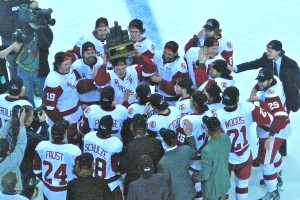
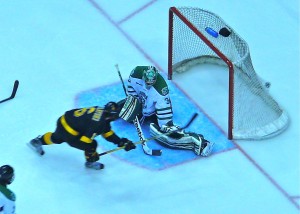
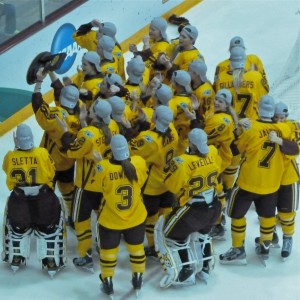
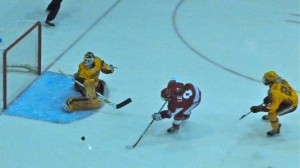
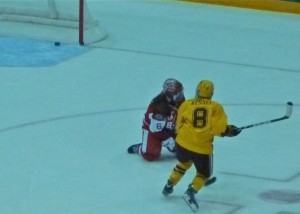
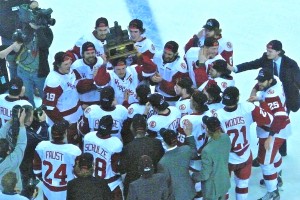
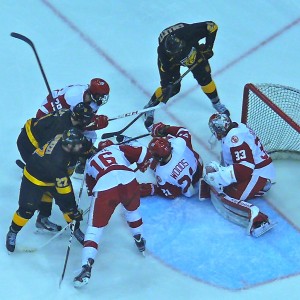
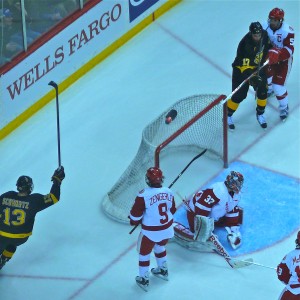
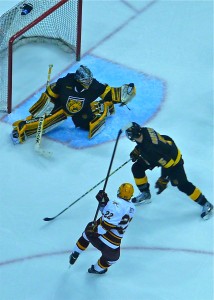
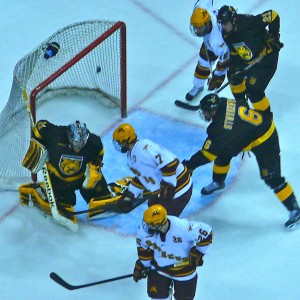
 John Gilbert is a lifetime Minnesotan and career journalist, specializing in cars and sports during and since spending 30 years at the Minneapolis Tribune, now the Star Tribune. More recently, he has continued translating the high-tech world of autos and sharing his passionate insights as a freelance writer/photographer/broadcaster. A member of the prestigious North American Car and Truck of the Year jury since 1993. John can be heard Monday-Friday from 9-11am on 610 KDAL(www.kdal610.com) on the "John Gilbert Show," and writes a column in the Duluth Reader.
John Gilbert is a lifetime Minnesotan and career journalist, specializing in cars and sports during and since spending 30 years at the Minneapolis Tribune, now the Star Tribune. More recently, he has continued translating the high-tech world of autos and sharing his passionate insights as a freelance writer/photographer/broadcaster. A member of the prestigious North American Car and Truck of the Year jury since 1993. John can be heard Monday-Friday from 9-11am on 610 KDAL(www.kdal610.com) on the "John Gilbert Show," and writes a column in the Duluth Reader.